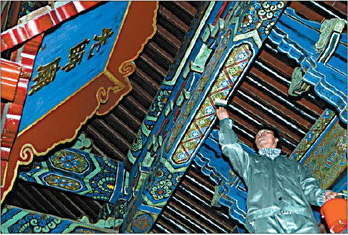In sprint to the Games, heritage has a good run
Updated: 2007-12-06 06:53
The da-ma, or women in their 60s or 70s, represent a heart-warming winter scene typical of Beijing's hutong.
|
|
Sporting gray woolen hats and red armbands, they talk enthusiastically about everything from neighborhood happenings to national politics - or the Olympics.
Wang Xiuyu is one of them - she has lived in the Cangjing Hutong beside the Yonghegong Lama Temple since she was married 36 years ago. Her eyes brightened when the conversation turned to the recent three-month renovation of her hutong.
"It has been here since the early Qing Dynasty (1644-1911); last year, the street had potholes and was bumpy, and the whole hutong looked run down," she said. "It is good the government spent money to pave the street and fix new gray bricks on the outer walls of the houses.
"It would have been even better if we also got free furnishings," she added with a mischievous smile.
Wang and her neighbors owe the improvement in their environment to the Olympics. Beijing has spent 600 million yuan ($81 million) on conservation and facelifts for cultural heritage areas in the past five years to hold the "People's Olympics" it pledged.
"Back in the 1990s, we had only 1 million yuan ($133,000) a year for conservation work, which is less than 1 percent of what we have today," said Kong Fanzhi, director of the Beijing municipal administration of cultural heritage. "Now we can get money much easier because of the Games."
The major cultural heritage sites that were conserved or renovated because of the Olympics are 17 royal palaces and gardens, 52 religious buildings, 38 ancient walls and tombs as well as 32 siheyuan courtyards. The Great Wall received 40 million yuan ($5.4 million) and the Neolithic Peking Man site of Zhoukoudian 8 million yuan ($1.08 million).
More than 1,500 precious ancient artifacts, including those made of bronze, gold and jade, were also unearthed during archaeological excavations ahead of the Olympic construction projects, said Kong.
The 15,000 families who lived in the ancient buildings and gardens were compensated for shifting out during renovation; and some have moved back.
"In fact, the compensation money we paid for each project could be 10 times the amount spent on actual conservation work," said Wang Yuwei, an official at the Beijing cultural heritage administration.
|
|
|
||
|
||
|
|
|
|
